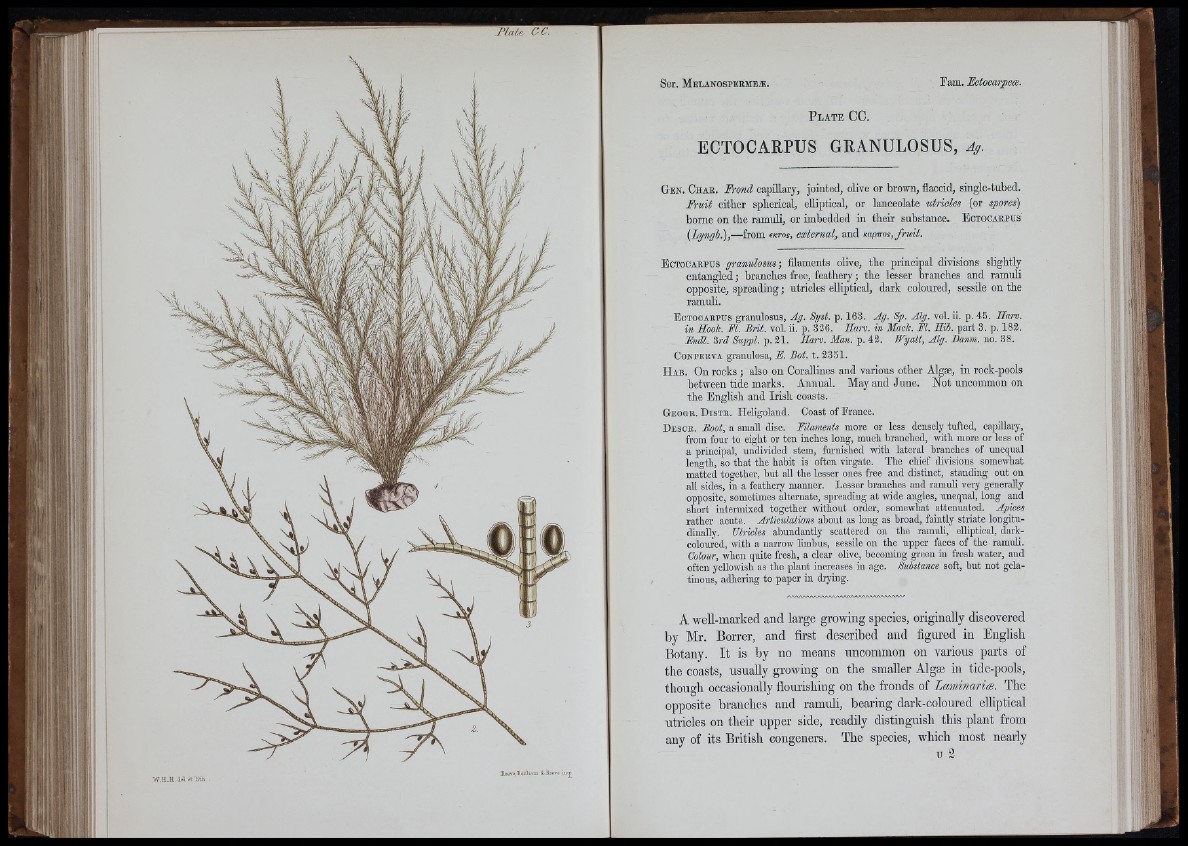
W .H .H .d J e tm .
Be8ve,B6rLha.m iJUeve iu ij
P l a t e CC.
ECTOCARPUS GRANULOSUS, Ag.
G e n . Ch a r . Frond capillary, jom te d , olive or b rown, flaccid, sin g le -tu b ed .
F ru it e ith e r sp herica l, e lb p tic al, o r lan c eo la te utricles (or spores)
b o rn e on th e ram u li, o r im b e d d ed in th e ir su b stan c e. E otooarptjs
[Lyngb.),—from cktos, external, a n d Kagaos, f r u i t .
E ctocarpus granulosus; filaments olive, the principal divisions slightly
entangled; branches free, feathery; the lesser branches and ramub
opposite, spreading; utricles eUiptical, dark coloured, sessile on the
ramub.
E ctocarpus granulosus, Ag. Syst. p. 163. Ag. Sp. Alg. vol. ii. p. 45. H a n .
in Hook. El. B n t. vol. ii. p. 326. H a n . in Mack. El. H ii. p a rt 3. p. 182.
Ekdl. 3rd Suppl. p. 21. H a n . Man. p. 42. Wyatt, Alg. Damn. no. 38.
Conferva granulosa, E. Bot. t. 2351.
H a b . On rocks ; also on Corallines and various other Algae, in rock-pools
between tide marks. Annual. May and June. Not uncommon on
the English and Irish coasts.
Geogr. D is t r . Heligoland. Coast of Erance.
D e sc r . Boot, a small disc. Eilaments more or less densely tufted, capillary,
from four to eight or ten inches long, much branched, with more or less of
a principal, undivided stem, furnished with lateral branches of unequal
length, so th a t the habit is often vhgate. The chief divisions somewhat
matted together, b u t all the lesser ones free and distinct, standing out ou
all sides, in a featheiy manner. Lesser branches and ramuli very generally
opposite, sometimes alternate, spreading at wide angles, unequal, long and
short intermixed together without order, somewhat attenuated. Apices
ra th e r acute. Articulations about as long as broad, faintly striate longitudinally.
Utricles abundantly scattered on the ramuli, elliptical, dark-
coloured, with a narrow limbus, sessile on the upper faces of the ramuli.
Colour, when quite fresh, a clear olive, becoming green in fresh water, and
often yellowish as tbe plant increases in age. Substance soft, b u t not gelatinous,
adhering to paper in drying.
A well-marked and large growing species, originally discovered
by Mr. Borrer, and first described and figured in English
Botany. It is hy no means uncommon on various parts of
the coasts, usually growing on the smaller Algae in tide-pools,
though occasionally flourishing on the fronds of Laninaria. The
opposite branches and ramuli, bearing dark-coloured elliptical
utricles on their upper side, readily distinguish this plant from
any of its British congeners. The species, which most nearly
u 2